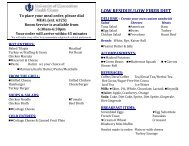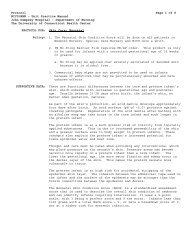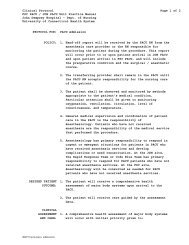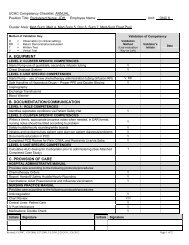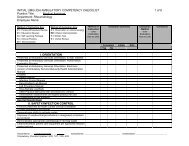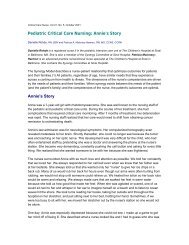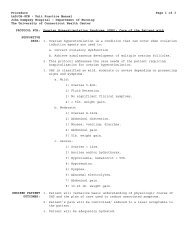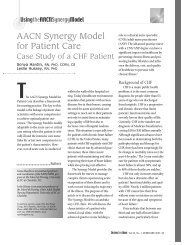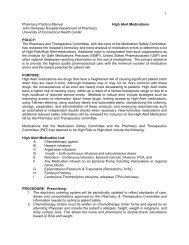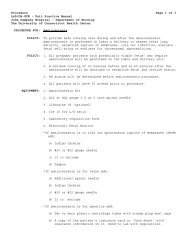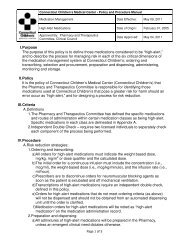You also want an ePaper? Increase the reach of your titles
YUMPU automatically turns print PDFs into web optimized ePapers that Google loves.
TMOperaOperating and Product CareInstructionsKPX 01700.GBKKX 52180.GB/2Aug 2000 Issue 1Jan. 2001
The vertical and horizontal lines printed in themargins adjacent to the text/illustrations in theseinstructions are for ARJO use only and should bedisregarded by the reader.Some <strong>of</strong> the information contained in theseinstructions may become outdated, due toimprovements made to the product in the future. Ifyou have any questions regarding these instructionsor your lifter, please contact ARJO or theirapproved distributor.The policy <strong>of</strong> ARJO is one <strong>of</strong> continuousdevelopment, and therefore reserve the right tochange specifications without notice.ARJO strongly advise and warn that only ARJOCompany Designated Parts, which are designed forthe purpose, should be used on equipment andother appliances supplied by ARJO, to avoidinjuries attributable to the use <strong>of</strong> inadequate parts.The ARJO Company’s Conditions <strong>of</strong> sale makespecific provision confirming no liability in suchcircumstances.‘Opera’, ‘Flites’ and ‘Lock and Load’ aretrademarks <strong>of</strong> the ARJO Group2
ContentsSECTIONPageNo.Foreword ..................................................... 4Safety Instructions...................................... 5Product description/function ..................... 6-12Parts referred to in this manual ................. 6-7Slings......................................................... 8-9Control Handset......................................... 10Dual Control panel .................................... 10Emergency stop button (red) ..................... 10Reset button (green) .................................. 10System failure lower override ................... 11System failure wind down facility ............ 11System cut-out switch ............................... 11Automatic cutout....................................... 12Automatic stop function............................ 12Battery discharge indicator........................ 12Service indicator........................................ 12Adjustable width chassis legs.................... 12Chassis castor Brakes ................................ 12Using your Opera ........................................ 13-28Before apparoaching the patient................ 13Powered opening ‘v’ chassis ..................... 13“Lock and Load” system jib...................... 13Using the 4 point spreader bar................... 13To lift from a chair ................................. 14To lift from a bed ................................... 15To lift from the floor .............................. 17At the toilet ............................................ 18Powered patient positioning spreader bar(if fitted) .................................................... 19Using the 2 point spreader bar................... 21To lift from a chair ................................. 21To lift from a bed ................................... 22Using the s<strong>of</strong>t stretcher.............................. 23Using the strap stretcher............................ 25Patient Scale (if fitted)............................... 28Lifter Battery charging .............................. 29-30Warnings for charging ............................... 29General safety Practices for Batteries ....... 29Care <strong>of</strong> your Opera ..................................... 31-33Sling Care and Cleaning............................ 31Lifter Care and Cleaning........................... 31Periodic Testing......................................... 32Service Advice .......................................... 32Labels........................................................... 34Technical Specification ............................... 35-36Lifter Dimensions...................................... 373
ForewordThank you for purchasing ARJO equipmentYour Opera is part <strong>of</strong> a series <strong>of</strong> quality productsdesigned especially for hospitals, nursing homesand other health care uses.We are dedicated to serving your needs andproviding the best products available along withtraining that will bring your staff maximum benefitfrom every ARJO product.Please contact us if you have any questions aboutthe operation or maintenance <strong>of</strong> your ARJOequipment.The touch panel label on the dual control paneldisplays several instruction symbols. The letter (i)shown on the open book icon indicates‘information’, and is an instruction to always readthe operating instructions before use. (See fig 1).The expected operational life <strong>of</strong> the Opera is 10years, providing it has been regularly serviced andmaintained as recommended in these instructions.The expected operational life <strong>of</strong> the consumableparts e.g. batteries, slings etc.is dependent on usage(see also ‘Care <strong>of</strong> Your Opera’ section).All references to the patient in these instructionsrefer to the person being lifted, and reference to theattendant refer to the person who operates the lifter.References to left and right <strong>of</strong> the lifter in theseinstructions are as viewed from the rear <strong>of</strong> theOpera, i.e. viewed from the dual control panel (seeFig. 1)Lifting operations in these instructions aredescribed as if lifting a patient from a chair, thesame operations can be performed effectively whenlifting a patient from a wheelchair or sittingposition on a bed, although a second attendantshould support the patient if the patient lacks sittingbalance.All operations in these instructions are described asif the attendant were using the control handset.Each operation described can be controlled usingthe control handset and/or the dual switch panel,situated at the rear <strong>of</strong> the mast.4
Product Description/FunctionParts referred to in this manual851641314P1389ab, P1391c, P1198a, P1391c, P1395e, P1396c, mP1142c712151620191118171093221222324Fig. 16
Product Description/FunctionFig. 1 Key1. Mast2. Adjustable chassis legs3. Braked castors4. Lifter manoeuvring handle5. Jib6. Mast top cover7. 4 Point spreader bar8. 2 Point spreader bar (if supplied)9. Patient positioning handle10. Lifter battery pack11. Battery release button12. Patient scale (if fitted)13. Control handset14. Dual control panel15. Emergency stop button16. Reset button17. System failure lower override18. System cut-out switch19. Battery discharge indicator20. Service indicator21. Stretcher frame (if supplied)22. S<strong>of</strong>t stretcher (if supplied)23. Strap stretcher (if supplied)24. Scoop stretcher (if supplied)7
Product Description/FunctionSlings• Note: All Opera slings will support190kg/420lbs), note: the extra extra largesling will support 200 kg (440 lbs) allslings are coded for size by havingdifferent coloured edge binding asfollows:Brown - Extra small - XSRed - Small - SYellow - Medium - MGreen - Large - LBlue - Extra Large - XLWhite - Extra Extra LargeA circular label is fitted to the lifter jib for quickcolour to size reference (see “Labels” section).A range <strong>of</strong> special purpose slings are available asaccessories, for these or for special size slings,contact your ARJO representative.Warning: Only use ARJO suppliedslings and stretchers that are designed tobe used with Opera. The sling pr<strong>of</strong>ilesillustrated (see fig. 2) will help to identifythe various ARJO slings and fabricstretchers available.If ARJO Flites (disposable slings) are tobe used with the Opera, then always referto the separate operating instructions forARJO Flites, (literature reference part No.MAX01720), as well as these instructionsbefore using.Warning: ARJO slings with headsupport have two pockets at the headsection which should contain plasticreinforcement pieces during use. Alwaysensure these reinforcement pieces havebeen inserted into the sling pockets beforeusing the sling.8
Product Description/FunctionARJO standard sling pr<strong>of</strong>iles that can be used with the operaP1390, P1143 a,b, P953 a, b, c, d, eS<strong>of</strong>t stretcherLoop slingLoop sling (with headrest)Four point toilettingsling (With headrest)Four point amputee slingFour point padded slingFour point unpaddedslingFour point mesh slingFig. 29
Product Description/FunctionControls and FeaturesControl Handset:- (see fig 3) Raising andlowering the jib and opening and closing thechassis legs, is achieved by pressing the appropriatebutton on the control handset. Note: icons withdirection arrows are printed on each button forquick reference.Chassis legopen Button“Raise”ButtonP1396bChassis legclose Button“Raise”Button“Lower”ButtonP1396aChassis legopen Button“Lower”ButtonFig. 4Chassis legclose buttonFig. 3If pressure is released during any function poweredmotion will cease immediately. Do not drop thehandset into water, e.g.: bath etc., although if thisdoes happen inadvertently no harm will come topatient or attendant.When not in use, the handset can be convenientlykept ready for use by hooking it over the handlesupport at the rear <strong>of</strong> the mast.Dual Control Panel:- (see fig 4) An additionalfeature fitted to the Opera, is a mast mounted dualswitch panel which operates in parallel with thecontrol handset enabling powered operations to becontrolled from the lifter mast as well as remotely,using the handset. As with the handset, icons withdirection arrows are printed on each button forquick reference.Emergency Stop Button (Red):- (See fig 5) If, inan emergency, you have to immediately stop anypowered movement, (other than by releasingpressure on the control handset button or dualswitch panel button), press the “emergency stopbutton”, situated on the rear <strong>of</strong> the mast.Once the emergency stop button has been operated,the green reset button will have to be re-engaged bypressing it in, before any powered movement canbe utilised.EmergencyStopResetBatterydischargeindicatorSystemFailureLowerOverrideFig. 5Reset button (green):- (See fig 5) Adjacent to theemergency stop button. It is used to reset the ‘poweron’ condition, once the emergency stop button hasbeen operated, also used to reset if the automaticoverload fuse has operated, indicated by the resetbutton projecting outwards slightly. If the fuse hasoperated and once reset, operates again, withdrawthe lifter from use and contact ARJO Servicedepartment or their appointed distributor.P1389bSystem cutout switchServiceindicator10
Product Description/FunctionSystem Failure Lower Override:- (See fig 5) Thiscan be used in the event <strong>of</strong> main control failure. Inthe unlikely event that the control handset or dualswitch panel fails to operate the lifter, with a patientstill supported by the sling or stretcher, provisionfor lowering has been made, using the “SystemFailure Lower Override switch”, situated on theright hand side <strong>of</strong> the controls console, a green andwhite identification label is positioned near theswitch, for quick and easy recognition. If pressureis released from the switch during use, loweringwill stop.Warning: The Lower Override switchwill only operate while the green resetbutton is in. Only use this switch in anemergency, do not use it for normalfunction lowering.System Failure Wind Down Facility:- (see Figs.6 & 7) If the electrical power fails completely dueto battery power loss or other electricalmalfunction, the jib can be lowered, by firstlyremoving the battery pack, then using a coin orscrewdriver slacken and remove the screw thatretains the mast top cover. Slightly lift the rear side<strong>of</strong> the top cover approximately 5 mm (3/16 in),Screwdriver/CoinABTopCoverWrenchFig. 6slide the cover forwards then lift it <strong>of</strong>f the mast.Identify and remove the hexagon wrench locatedinside the mast. Using the wrench slacken the shaftlockscrew located at the top front <strong>of</strong> the mast (seefig. 7c), turn it 3 full turns anti-clockwise. Identifythe hexagonal hole in the shaft centre inside themast (see fig. 7d) and using the wrench turn theshaft clockwise to lower the patient.• Note: One full clockwise rotation <strong>of</strong>the shaft lowers the mast jib by 10mm (3/8 in).P1398a,bCShaftlockscrewFig. 7Hold the hexagon wrench securely into the shaftand do not release hand contact with the wrench toensure control is maintained during the loweringprocedure.Once the patient has been lowered and removedfrom the lifter ensure the components are reassembledby reversing the above procedure.If the system failure lower override switch or winddown facility has to be operated the lifter must thenbe withdrawn from use immediately and the ARJOService <strong>Department</strong> or their appointed distributorcontacted.System Cut-Out Switch:- (See fig 5) If the lifterfunctions fail to operate when pressing the buttonson the control handset or dual switch panel.Check that the “green” reset button is pressed inand check that the battery pack is in a good state <strong>of</strong>charge, if the lifter still fails to operate, check thesystem cut out switch, situated on the right handside <strong>of</strong> the controls console above the loweroverride switch. If the cut-out has operated, theswitch will protrude from its mount, press theswitch in to reset.DShaftWarning: If the mast is in a high positionand the wind down facility has to beutilized always ensure that suitable andsafe measures are taken to gain access tothe top cover.• Note: To enable the shaft lockscrewto be tightened three full turns the shaftmay have to be rotated slightly to makealignment possible, this is aided byidentifying the alignment mark on the top<strong>of</strong> the shaft and then rotating the shaftuntil the mark aligns with the axis <strong>of</strong> thelockscrew.P1398c,d11
Product Description/FunctionWarning: If the system cut out switchoperates again withdraw the lifter fromuse and contact ARJO Service<strong>Department</strong>.Automatic cut out:- (not an operator control but afunction built into the lifter electronics)If the lifter is inadvertently overloaded (trying tolift a patient heavier than permitted), an automatic‘cut out’ operates to prevent the lifter lifting a loadin excess <strong>of</strong> one and a half times the maximumrated load; this will stop the lift motionautomatically.If this occurs, when pressure is released from thelift button on the handset or dual control theelectronics will, after a short delay, reset and enablethe patient to be lowered only by pressing eitherlower button. Remove the patient from the lifter.Automatic stop function:- (not an operator controlbut a function built into the lifter electronics)Great care should be taken not to lower the spreaderbar, or stretcher onto the patient or any otherobstruction, but if this should happen inadvertentlythe motor will stop and downward movement willbe held by the obstruction. If this occurs releasepressure from the ‘lower’ button immediately,operate the ‘raise’ button until clear, then removethe obstruction.Battery Discharge Indicator:- (See fig 5) Is asmall LED display which shows the chargecondition <strong>of</strong> the lifter battery. (See also ‘BatteryCharging Section’ for complete description).Service Indicator:- (See fig 5) Is a small LCDdisplay which shows the total duration <strong>of</strong> poweredoperation (in hours) <strong>of</strong> the lifting and loweringprocedure. This is primarily intended as an aid toservice engineers.Adjustable width chassis legs:- (See fig 8) Byoperating the appropriate button on either thecontrol handset or dual control panel on the lifterthe chassis legs can be opened to any variablewidth. When pressure is released from the button,movement will stop and the chassis legs willremain securely in position. Always transport thechassis legs in the narrow (closed) position.Fig. 8Chassis castor Brakes:- (See fig 9) The chassisrear castors have brakes which can be foot operatedif required, for example, when leaving the patientunattended, or to keep the Opera in position.Fig. 9Jib and spreader bars/stretcher frame:-(see fig 1) If your Opera has not been supplied witha ‘dedicated’ or permanently attached, poweredpatient positioning 4 point spreader bar (P.P.P.)then it will be supplied with the ‘Lock and Load’system jib. This jib is fitted with a carrier, able toaccommodate any <strong>of</strong> the Opera jib attachments, eg.2/4 point spreader bars, stretcher frame etc. (see“Using your Opera” section for full instructions onfitting or changing attachments).P1392bmP1332e,f12
Using your OperaBefore Approaching the Patient:-Ensure the battery pack supplied is fully chargedbefore use (for charging, see instructions in “LifterBattery Charging” section). When the battery packis fully charged remove it from the charger unit andinsert it into the battery position <strong>of</strong> the Operasituated at the rear <strong>of</strong> the mast (see Fig. 1) by firstly,locating the recess across the bottom <strong>of</strong> the batterywith the protrusion at the bottom <strong>of</strong> the batteryposition, then pivot the battery into position untilthe retaining catch operates. Electrical connectionwill be made automatically.Ensure the green reset button (situated on thecontrol console below the dual control panel) ispressed in (see fig. 5)Ensure a selection <strong>of</strong> sling types and sizes are easilyavailable for all types <strong>of</strong> lift likely to beencountered when using the ARJO Opera.The attendant should always tell the patient whatthey are going to do, and have the correct size slingready. Where possible, always approach the patientfrom the front.AttachmentyokeCarrierRetainingcatchP1391a, P1439a, P1439bWarning: To ensure maximum patientcomfort, do not allow the patient to holdonto the spreader bar.If required, the chassis legs may be opened to goaround a chair or wheelchair.Powered opening ‘V’ chassis:-Select the appropriate button on the control handsetor dual switch panel and keep it depressed until therequired width is achieved. To close, press theappropriate button, movement will stop if pressureis released, whether opening or closing.Warning: When opening or closing thelegs on a powered chassis, care must betaken not to allow anyone to stand in theway <strong>of</strong> the moving chassis legs.Transport the Opera with the chassis legsin parallel (closed) position only.Opera ‘Lock and Load’ System(see figs. 10 & 11)If your Opera has not been supplied with a‘dedicated’ or permanently attached poweredpatient positioning (PPP) spreader bar, then it willbe supplied with the ‘Lock and Load’ System jib.You may need to fit or change the attachment, (i.e.:spreader bar or stretcher fame) proceed as follows:-Fig. 10To remove an existing attachment, hold the unitcarefully and to release, depress the retaining catchon the attachment yoke (see fig. 10). Then lift theyoke upwards and away from the carrier and storecarefully for future use. Select the attachmentrequired then carefully lift the unit up and allow therecess in the yoke to fit around the carrier shaft.Ensure the yoke drops down over the carrier and theretaining catch operates (see fig. 11), locking can bechecked by attempting to lift the yoke withoutdepressing the retaining catch.13
Using your OperaP1391bP1392cFig. 11Warning: Care must be taken when theweight <strong>of</strong> the unit comes away from thejib.For larger attachments or if in any doubtabout being able to lift and hold theattachment securely use more than oneperson for the operation, or support theattachment on a bed or chair.Using the 4 point spreader barEnsure the spreader bar is securely connected to thejib before commencing with the lifting procedure.(‘Lock and Load’ system jib only).To Lift from a ChairPlace the sling around the patient so that the base <strong>of</strong>his/her spine is covered, and the head support areais behind the head. Pull each leg piece under thethigh so that it emerges on the inside <strong>of</strong> the thigh.(See fig. 12).P1146a,bFig. 13Ensure that the Opera is close enough to be able toattach the shoulder clips <strong>of</strong> the sling to the spreaderbar. To accomplish this you may have to put thepatients feet on, or over the chassis.Once the Opera is in position, attach the shoulderstrap attachment clips to the pegs on the spreaderbar. (See fig. 14).• Note: The chassis rear castors havebrakes which can be foot operated whenrequired (see fig.9). Do not apply thecastor brakes at this stage, as the position<strong>of</strong> the patient will adjust to his/her owncentre <strong>of</strong> gravity when lifted.P1392d, P1002a,b,cFig. 12Ensure the positioning handle on the spreader bar isfacing away from the patient, and that the wide part<strong>of</strong> the spreader bar is at, or just below shoulderlevel. (See fig. 13).Fig. 14Warning: Apply the castor brakes whenleaving the patient unattended or to keepthe Opera in position on a sloping surface.Press down on the positioning handle <strong>of</strong> thespreader bar and attach the leg strap attachmentclips. (See fig. 15).14
Using your OperaP1392eP1393fFig. 15If necessary, lower the spreader bar using thehandset control, being careful not to lower it ontothe patient, although if this should happeninadvertently, there is a built in cut-out devicewhich will prevent any further downwardsmovement. Do not continue to press the handsetlowering button.• Note: If the handset button isreleased during lifting or lowering,powered motion will stop immediately.Fig. 16Before transportation, turn the patient to face theattendant at approximately normal chair height.(See fig. 17). This gives confidence and dignity andalso improves the Opera mobility.P1393dWarning: IMPORTANT: Alwayscheck that the sling attachment clips arefully in position before and during thecommencement <strong>of</strong> the lifting cycle, and intension as the patient’s weight isgradually taken up.Raise the patient by operating the handset control,move the lifter away from the chair then carefullylift the positioning handle until the patient isreclined in the sling - the head support will nowcome into use. (See fig. 16). This is the mostcomfortable position for transportation, as itreduces pressure on the thighs. The angle <strong>of</strong> reclinecan be adjusted for increased comfort if the patientis restless.Fig. 17Remember to release the brakes, if they have beenapplied, before attempting to transport the patient.When lowering the patient back into a chair - orwhen transferring from bed to chair - push down onthe positioning handle to put the patient into a goodsitting position. This avoids further lifting effort.Take care not to push down too quickly, as this mayjerk the patient’s head forward.Warning: When lowering the lifterensure that the patient’s or attendant’slegs and feet are well clear <strong>of</strong> the movingmast.15
Using your OperaTo Lift from a BedBefore lifting a person from a bed, ensure there issufficient clearance underneath to accommodatethe Opera chassis legs.Position the patient onto the sling by rolling thepatient towards you then folding the sling in halfand placing it behind the patient’s back (see fig.18). Position the sling carefully so that when rolledback the patient will lie centrally on the sling (seefig. 19) and check that the head support area <strong>of</strong> thesling covers the patient’s neck.P1133bFig. 18Fig. 20Using the adjustable width chassis, it is possible tomake adjustments to chassis leg widths to assistmanoeuvrability around obstructions, for example,bed legs.Position the Opera so that the spreader bar is justabove, and centrally situated over the patient.Warning: Care must be taken not tolower the spreader bar onto the patient.P1393eP1022aP1395a, P1002 a,b,cFig. 19• Note: When rolling the patient backonto the sling, roll the patient slightly inthe opposite direction so that the foldedpart <strong>of</strong> the sling can be brought out.Alternatively, the patient can be brought into asitting posture then position the sling as detailed inthe section “To Lift From A Chair”.Approach the bed with the open side <strong>of</strong> the spreaderbar towards the patient’s head. (See fig. 20).Fig. 21Using the positioning handle, tilt the spreader baruntil the shoulder attachment points can beconnected to the sling shoulder strap attachmentclips. (See fig. 21).Press down on the positioning handle untilconnection <strong>of</strong> the sling leg pieces is possible. (Seefig. 22) The leg pieces must be brought under thethighs to connect up, this may involve lifting oneleg at a time to connect up. You may need to lowerthe spreader bar a little more, using the handsetcontrol.16
Using your OperaFig. 22When lifting from the bed, some attendants preferto connect the leg pieces first. This particularlyapplies to patients with large thighs. In this case,raise the hip and knee into maximum flexion, andattach the leg strap attachment clips, then tilt thespreader bar towards the shoulders for connection.Warning: IMPORTANT: Alwayscheck that the sling attachment clips arefully in position before and during thecommencement <strong>of</strong> the lifting cycle, and intension as the patient’s weight isgradually taken up.P1395bWarning: When lowering the lifterensure that the patient’s or attendant’slegs and feet are well clear <strong>of</strong> the movingmast.Only when the patient’s body weight isfully supported by the bed may the slingleg connection clips be detached,followed by the shoulder connections.Move the Opera away before removing the slingfrom under the patient. If transferring the patient toa chair refer to the section “To Lift from a Chair”.To Raise from the FloorPut the sling around the patient as before, by usingthe rolling or sitting up method. Depending oncircumstances, space and/or position <strong>of</strong> patient etc.approach the patient with the open part <strong>of</strong> thechassis. Open the chassis legs if necessary, and liftthe patient’s legs over the chassis as shown infigure 24.P1394aLift the patient using the handset control, and adjustto a comfortable position for transfer. (See fig. 23).The specially designed sling together with its’integral head support, enables one person to carryout the complete lifting function without additionalhelp.P1395dFig. 23If returning the patient to a bed, move into thedesired position above the bed adjusting the slingposition as necessary, and then lower using thehandset control.Fig. 24The patient’s head and shoulders could be raised onpillows for comfort, if required, but this is notessential when connecting up the sling to thespreader bar.With the open part <strong>of</strong> the spreader bar pointingdown towards the shoulders, attach the shoulderstrap attachment clips, as shown in figure 25 andinset.17
Using your OperaP1394b, P1002 a,b,cchassis before continuing to lift. (See fig. 27). Theleg sections <strong>of</strong> the sling will tend to be fairly highin the crotch, so straighten them out for addedcomfort. The patient may be positioned in a chair,or placed onto a bed. If the patient is prone toextensor spasm, he/she may be lifted by the Opera,but special attention should be paid to supportingthe legs during the early part <strong>of</strong> the lift.P1394dFig. 25Once connected, raise the hip and knee intomaximum flexion, and push down on thepositioning handle in order to connect the leg strapattachment clips as shown in figure 26. This willhave the effect <strong>of</strong> raising the patient’s head andshoulders slightly.P1394cFig. 27When lifting patient’s with leg amputations, use thedouble amputee sling (available as an accessoryfrom ARJO Ltd). This sling is specially designed toaccommodate the differing patient centre <strong>of</strong>gravity.Fig. 26Warning: IMPORTANT: Alwayscheck that the sling attachment clips arefully in position before and during thecommencement <strong>of</strong> the lifting cycle, and intension as the patient’s weight isgradually taken up.When lifting from the floor, some attendants preferto connect the leg pieces first. This in particularapplies to the very large patient with large thighs. Inthis case, raise the hip and knee into maximumflexion, and attach the leg straps first, then tilt thespreader bar towards the shoulders to enable theshoulder straps to be connected.When all the straps have been properly connected,raise the patient from the floor in a semi-recumbentposition. Supporting the head can be comfortableand reassuring for the patient. Once raised from thefloor, ensure the patient’s legs are clear <strong>of</strong> theWarning: When lowering the lifterensure that the patient’s or attendant’slegs and feet are well clear <strong>of</strong> the movingmast.Transportation <strong>of</strong> a patient should alwaysbe done with the chassis legs parallel(closed) manoeuvrability will be easier,especially through doorways, with thechassis legs closed. The patient should bepositioned facing the attendant. (See fig.17). Apply the chassis brakes if leavingthe patient unattended.At the ToiletFor toileting a patient, use the toilet sling with headrest. The toilet sling is fitted in a similar manner tothe standard four point sling, except, the sling is nottaken to the base <strong>of</strong> the patient’s spine, but fittedwith the top <strong>of</strong> the head support area <strong>of</strong> the slinglevel with the top <strong>of</strong> the patients head as a guide topositioning. (See fig 28)18
Using your OperaP1130athe toiletting sling provides a very effective method<strong>of</strong> toiletting dependent patients.Once the patient has been lifted and transported tothe toilet, position the lifter so that the patient ispositioned above the toilet seat.“Head Section”support strap bucklesFig. 28The ARJO toilet sling has been specially designedto help support patients whilst toiletting.Warning: It is essential to familiariseyourself with the correct method <strong>of</strong> usebefore any attempt is made to lift apatient.Always ensure that the patient hassufficient trunk and head self-control tobe safely lifted in the toilet sling. If in anydoubt use the standard type sling.To provide the best possible access when toilettingthe sling has a wide commode opening and because<strong>of</strong> this it is essential that:-(a) The correct size sling is chosen, relative to theweight and height <strong>of</strong> patient and(b) Both <strong>of</strong> the patient’s arms are positionedoutside the sling, over the padded areas butunder the “head section” support straps’ (Seefig. 28) this will help prevent the patient fromsliding through the sling.• Note: It is advisable to release the“head section” support strap bucklesprior to fitting the sling, once the sling isaround the patient, reconnect the supportstrap buckles ensuring the patient’s armsare positioned over the sling.Warning: Always ensure that thepatient, when suspended, is in an uprightsitting position, as shown in figure 28.When used in accordance with these instructionsWarning: When lowering the lifterensure that the patient’s or attendant’slegs and feet are well clear <strong>of</strong> the movingmast.Apply the chassis brakes.Unbutton and / or remove the patients garmentslower the patient to a comfortable sitting position.Warning: Always use the toilet slingwith caution, encourage the patient tohold tightly to the sling to avoid slidingout. Do not use the toilet sling for liftingand transportation apart from toilet visits.Powered Patient PositioningSpreader Bar (if fitted)If your lifter has been supplied fitted with aPowered Patient Positioning (P.P.P.) spreader bar,the use <strong>of</strong> this type <strong>of</strong> spreader bar including slingpositioning with patient, sling connection to thespreader bar, and patient handling, is the same asthe non-powered 4 point spreader bar describedpreviously in these instructions.MotorcoverGearboxcoversJibSling attachment lugsSupportframeIsolator/cut-<strong>of</strong>fswitchSpreaderbarPositioningcontrol handleFig. 29The fundamental difference being, the “P.P.P.”spreader bar has the added advantage <strong>of</strong> enablingthe patient positioning manoeuvre to be performedwith minimal physical effort by the attendant.P1397a19
Using your OperaRotation <strong>of</strong> the P.P.P. spreader bar is manual and isthe same as the manual patient positioning spreaderbar.Warning: Before using your lifter whenfitted with the P.P.P. spreader bar,familiarise yourself with the various partsas illustrated in figure 29. then read andthoroughly understand the followingoperating instructions.The P.P.P. spreader bar must be used inaccordance with the followinginstructions and in conjunction with theoperating instructions previouslydescribed for the manually operated (nonpowered)four point spreader bar.The lifting capacity <strong>of</strong> the lifter whenfitted with the P.P.P. spreader bar remainsthe same as the non-powered patientpositioning spreader bar version.The (P.P.P.) is fully waterpro<strong>of</strong> and is classified byARJO as a wet environment unit and has a blue andwhite circular label to qualify this, attached. (See“Labels” Section). This label signifies that thelower end <strong>of</strong> the unit may be immersed in bathwater, or used for showering.To operate the powered patient positioningfunction, ensure the isolator/cut <strong>of</strong>f switch is in theon position (see fig. 30)Fig. 31• Note: A slight pivoting movement <strong>of</strong>the handle may be noticed, this is correct,and is how the direction sensing deviceoperates.Powered movement will continue in the direction<strong>of</strong> hand pressure until the limit <strong>of</strong> travel has beenreached, or until pressure is released from thehandle.Warning: To stop any poweredmovement, release pressure from thehandle or press the isolator/cut <strong>of</strong>f switch.P1397bOffP1389dThe spreader bar will remain firmly in position,once powered movement has ceased.• Note: The isolator/cut <strong>of</strong>f switchcan remain in the ON positionindefinitely if required, it will not drainany power from the battery.OnFig. 30When ready to perform the patient positioningfunction (as described previously) hold thepositioning handle and apply a lifting or loweringaction as necessary (see fig. 31)Warning: Before and during operatingthe powered patient positioning spreaderbar, ensure all obstructions are well clear<strong>of</strong> the spreader bar, support frame and jib.20
Using your OperaPatient positioning function cut outfuseIf an obstruction is encountered accidentally duringupward or downward movement then an automaticcut out fuse will operate to protect the system. Thefuse will reset quickly once powered movement hasceased, the obstruction or lifter should be moved toavoid this re-occurring. If the patient positioningfunction cut out fuse operates again, withdraw thelifter from use and contact ARJO Servicedepartment.Care Of Your Powered PatientPositioning Spreader BarFor general care refer to the “Care Section”. Referin particularly to paragraphs relating to cleaning,plastic parts, labels, etc.Warning: The motor and gearboxcovers house moving parts, care must betaken not to damage these covers. Shouldthe covers become damaged, withdrawthe lifter from use and arrangereplacement <strong>of</strong> the cover/s before re-usingthe lifter.Warning: Before attaching the slingensure the spreader bar is rotated intoposition so the eventual lift will resemblefigure 32.The slings to be used with the 2 point spreader barare the ARJO loop slings (see fig. 2). They areavailable in four sizes (small, medium, large andextra large) all colour coded. A range <strong>of</strong> morespecialised slings are available please contactARJO or their authorised distributors for details.The loop sling is available with or without headsupport. A bathing mesh sling is also available in allthe four sizes with or without head support.To Lift from a ChairMethod 1 - Easing the patient forward, if necessary,slide the sling down the patient’s back until seam“C” (see fig. 33) reaches the base <strong>of</strong> the spine. Takeattachment points “B” and loop the tails <strong>of</strong> the slingunderneath the patient’s thighs, ensuring the slingpieces are not twisted underneath the patient. Hookthe loops onto the “opposite side” outer hooks onthe spreader bar. (See fig. 34).Warning: Apart from cleaning no usermaintenance is required, but somecomponents may need to be serviced orreplaced periodically. This should becarried out by an ARJO qualified serviceengineer. For more information contactARJO or their approved distributor. Seealso ‘Servicing Advice’ in the ‘Care’section.BACAP1395e, mP1138e/2Using the 2 point spreader barP1394fBFig. 33Fig. 3221
Using your OperaMETHOD 1mP1183a/2METHOD 3P1395e, mP1138b/2Fig. 34Method 2 - As method 1 above, but pass each tailportion <strong>of</strong> the sling under both thighs, and then outthe other side before attaching points “B” to theouter hooks on the spreader bar (see fig. 35).METHOD 2Fig. 35Method 3 - As method 1 above, but loop a tailportion <strong>of</strong> the sling under each thigh and attach tothe same side hook as the shoulder attachment (leftstraps to left hook and right straps to right hook).This method holds the legs in abduction, and isuseful for toiletting (see fig. 36).P1395e, mP1138c/2Once the sling has been positioned and attachedsecurely to the spreader bar then lifting can becarried out using the control handset. For generalpatient manoeuvring and transportation see alsosection “using 4 point spreader bar”.Apart from the methods listed above, the 2 pointspreader bar with loop slings is also extremelyuseful for lifting patients who have contracted legs,where the patient leg position prohibits the use <strong>of</strong>the 4 point spreader bar. Attach the sling in thenormal manner as described in “lifting from thebed”.To Lift from a BedFig. 36Warning: Always check that all thesling attachment loops are fully inposition before and during thecommencement <strong>of</strong> the lifting cycle, and intension as the patient’s weight isgradually taken up.When lowering the Lifter ensure that thepatient’s or attendant’s legs and feet arewell clear <strong>of</strong> the moving mast.Place the sling under the patient as if it were adrawsheet. Flex the patient’s legs, and bring thesling leg pieces under the thighs, attach the sling tothe spreader bar using any <strong>of</strong> the methods 1-3above.Warning: IMPORTANT: Check that allfour points <strong>of</strong> the sling are securelyconnected before lifting.22
Using your OperaTo Lift from the Floor(Some attendants prefer to use a larger sling for thisoperation.)Raise and support the patient into a sitting, or halfsitting position. Feed the sling down the patient’sback, bring the leg pieces <strong>of</strong> the sling into position.Raise the patient’s legs over the chassis, and bringthe lifter into position as shown in figure 37. Withthe jib as low as possible, attach the shoulder loops.Bend up the patient’s knees to connect up the legpieces.Fig. 37Warning: Check all the loops aresecurely attached before lifting.When lifting or lowering a patient who is supportedby a sling it is not necessary to use the brakes, thisallows the Lifter to move to the correct positionrelative to the centre <strong>of</strong> gravity <strong>of</strong> the patient.Warning: Apply the castor brakes whenleaving the patient unattended or to keepthe Opera in position on a sloping surface.P1394eUsing the S<strong>of</strong>t StretcherThe s<strong>of</strong>t stretcher is intended for use with thestretcher frame and is available in two sizes, largeand extra large. It is also supplied in both plainpolyester or polyester mesh for washing use, bothtypes are available with or without commode hole.To lift a patient using the stretcher frame and s<strong>of</strong>tstretcher proceed as follows:-Identify the head <strong>of</strong> the s<strong>of</strong>t stretcher, a label sewnto the head end will confirm this.Warning: Position the s<strong>of</strong>t stretchersling as shown in figure 38 by rolling thepatient as if inserting a drawsheet. Ensurethe top section <strong>of</strong> the sling (indicated bythe label attached to the sling) is under thepatient’s head, with the top edge <strong>of</strong> thesling level with the top <strong>of</strong> the head. Withthe stretcher frame as high up as possible(but not to come into contact with thepatient, should it swing accidentally),move the Lifter until the frame is directlyover the patient, the frame is symmetricaland can be used either way round. (SeeFig. 39). Lower the stretcher framecarefully over, and just clear <strong>of</strong> thepatient, aligning the centre <strong>of</strong> the frameapproximately over the patient’s navel.Connect all the sling loops securely(see fig 40). Note: The attachment strapshave several connection loops, choosewhichever loop is considered the best toenable the patient to lie in the mostcomfortable position. (See fig 41).P1393aWhen the patient has been returned to the bed he/she may be reclined before the sling is detached.Warning: When lowering the jib ensurethat the patient’s or attendant’s legs andfeet are well clear <strong>of</strong> the moving mast.Fig. 3823
Using your OperaP1393bleave the patient at 90º to the mast, in this way theLifter and patient can be moved through thedoorway sideways.Fig. 39P1396dFig. 42Fig. 40Warning: It is essential to keep thepatient at approximately normal bedheight to ensure stability <strong>of</strong> the unit andwithout losing patient/attendant contact.When lowering the jib ensure that thepatient’s or attendant’s legs and feet arewell clear <strong>of</strong> the moving mast.The stretcher frame is classified by ARJO as a wetenvironment unit, and has a blue and white circularlabel to qualify this, attached, (See “Labels”section). This label signifies that the unit may beimmersed in bath water. or used for showering.P1393cP1392aWarning: Only use s<strong>of</strong>t stretchers thathave every attachment strap colouredblue.Note: The “head end” straps have a blacktab stitched to them to enable correctusage with other ARJO stretcher frames.Do not use any other type <strong>of</strong> s<strong>of</strong>t stretchersling with the ARJO Opera.Fig. 41Raise and withdraw the patient away from the bed.If preferred, rotate the stretcher frame until thepatient’s feet are in proximity to the mast (see fig42). In this position, the complete unit may betransported through wide doorways. Alternatively,24
Using your OperaUsing the Strap StretcherSide Section(Right hand)Suspensionpoint labelHead End(Straps closer together)End tubemP1278: P1005a2, 1005b, P1167a, P1169, P1265End tubeSide Section(Left hand)Cross StrapsClaspSuspension strapsStrap GuideStrap LockingClampApprox.200mm (8”)Side Section Orientation LabelPatients Weight(Loose end <strong>of</strong> strap)Firstly attach the 12 cross straps to one <strong>of</strong> the sidesections (see fig.43), by pushing each strap througha locking clamp and locking by pressing the claspfully down, initially leave approximately 200mm (8inches) <strong>of</strong> strap outside the clamp (see inset t<strong>of</strong>ig.43).Warning: Red and green indicatorarrow labels indicate the correct positionsfor frame assembly, noting that the threeclosely positioned strap clamps go to thehead end <strong>of</strong> the patient, (a label on eachside section also indicates this).Ensure the patient to be lifted is free <strong>of</strong> bed covers,place one end tube above the patient’s head and onebelow the feet. Next, place the “unstrapped” sideLoose end <strong>of</strong> strapFig. 43section to the side <strong>of</strong> the patient (clampsuppermost) (see fig. 44) and push each end tubethrough the corresponding holes in the side sections(matching the coloured arrowed labels).Hold the “strapped” side section with the longerlength <strong>of</strong> the straps hanging towards the patient andplace it on the bed beside the patient, with thelonger length <strong>of</strong> the straps folded under the sidesection (see fig. 45). Connect the end tubes asbefore (matching the coloured arrowed labels).25
Using your OperaP1006b• Note: If desired the straps may bepassed under the pillow thereby leaving itunder the patient’s head for addedcomfort (see fig 47).End <strong>of</strong> cross strap to bepushed under patientStrapguidemP1279: P1006d2, P1167bFig. 44Slide any strap that can be easily done so, under thepatient, perhaps by carefully lifting the patient’shead and legs. For straps under the weight <strong>of</strong> thepatient use the strap guide as follows.Loose end<strong>of</strong> strapFig. 46Warning: With obese patientsespecially, or under buttocks, care mustbe taken initially, not to trap any skin, asthe strap guide is fed under the patient.Continue until all the straps are under thepatient and through the clamps, ensureeach strap is pulled tight and locked intoposition by pressing each clasp fullydown (see fig. 43 and 48).All cross straps must enter directly intothe clamps, and must not be passedaround the side section (see fig. 43)Check that both end tubes are fullylocated into each side section (with thecorrect matching arrow labels).Fig. 45Thread the long section <strong>of</strong> the strap that is to gounder the patient through the strap guide as showninset in figure 46. Then gently push the strap andguide under the patient (see fig. 46) until the strapcan be pulled clear and connected through theopposite strap clamp. Slide the guide back out fromunder the patient keeping the guide under thepositioned strap.Warning: If not already attached, fix thefour suspension straps in the positionsindicated by labels on the side sections(see fig 49)26
Using your OperaP1140cOnce connected, operate the Lifter to lift the patientclear <strong>of</strong> the bed, then either, rotate the stretcherframe until the patient’s feet are in proximity to themast. In this position, the complete unit may betransported through wide doorways. Alternatively,leave the patient at 90º to the mast, in this way theLifter and patient can be moved through thedoorway sideways.Fig. 47Warning: Before a patient is lifted, it isessential that all the cross straps arelocked into the clamps and positionedcorrectly as shown in fig. 43, and that allsuspension straps are securely attached tothe correct support hooks on the stretcherframe.Bring the Lifter towards the bed andposition the stretcher frame, centrallyover the patient, so that the suspensionstraps can be securely attached over thehooks, indicated with a hook icon label,(see fig 50).The strap or scoop stretcher should hangsymmetrically from the stretcher frame.IMPORTANT: Always check that all thestretcher suspension straps are fully inposition before and during thecommencement <strong>of</strong> the lifting cycle, and intension as the patient’s weight isgradually taken up.Fig. 49P1140bmP1280: P1006a, P1265Warning: It is essential to keep thepatient at approximately bed height, toensure stability and without losingpatient/attendant contact.When lowering the jib ensure that thepatient’s or attendant’s legs and feet arewell clear <strong>of</strong> the moving mast.Fig. 4827
Using your OperamP1389a, P1396d, P1265Strap and scoop stretcherconnection hook positionslabel - hook positions for strap andscoop stretcher attachment strapsFig. 50• Note: Individual patient supportstraps can be slackened and removed ifaccess is required to any part <strong>of</strong> thepatient needing attention.Warning: Do not remove too manystraps at one time to ensure the patient issecurely supported.When the patient is returned and lowered on to thebed, the strap stretcher may be removed, oncedisconnected from the stretcher frame, byslackening all the clamps on one side section andgently pulling each strap through under the patient.Disconnect and remove the frame, store carefullyfor future use.Patient Scale (if fitted)See seperate supplementary operating instructions.28
Lifter Battery ChargingThe Opera incorporates a battery dischargeindicator, situated on the rear side <strong>of</strong> the controlsconsole (see Fig. 1). The display shows ten levels <strong>of</strong>battery state ranging from fully charged on the rightto very low on the left (green, through amber to red)Danger: The charger is for indoor useonly.Only use the charger unit in a dryenvironment, do not use it in thebathroom.Do not expose the charger unit or batterypack to rain or spray and do not immersein water.Only use the ARJO battery that issupplied to be used with the OperaThe battery charger is for use only withARJO supplied batteries that are to beused with the OperaThe battery charger is for use with sealedlead acid batteries only.Under no circumstances should thecharger be used to attempt to rechargenon-rechargable batteries.Do not attempt to open or tamper with thecharger unit in any way, for any repair thecharger must be sent to the manufacturerThe mains electricity socket must beeasily accessible. should a faultycondition occur switch <strong>of</strong>f and remove theconnection plug from the socket.Only use ARJO components that havebeen specifically designed for the purposewhen charging batteries.Warning: To avoid overheating, thecharger must not be covered whilst in use.No smoking or naked flames in batteryvicinity.Do not expose the charger unit to dust.Do NOT charge batteries in a sealedcontainer.Do NOT place batteries near, or dispose<strong>of</strong>, in a fire.Do NOT short circuit a battery.Warning: Do NOT store batteries attemperatures in excess <strong>of</strong> 60°C (140°F).Do NOT crush, puncture, open, dismantleor otherwise mechanically interfere withbatteries.Should the battery casing becomecracked, and electrolyte come into contactwith skin or clothing, wash immediatelywith water.If the electrolyte contacts the eyes, washimmediately with copious amounts <strong>of</strong>water, and seek medical attention.When disposing <strong>of</strong> batteries, contact theappropriate local authority for advice.The abbreviation “Pb” shown adjacent tothe recycling and trash bin symbols on thebattery pack label is the element symbolfor lead, and indicates that the batterycontains lead and therefore should not bedisposed <strong>of</strong> in the normal manner butmust be recycled.For more details <strong>of</strong> caring for your lifter batteryrefer to the ‘Battery Care’ literature, ARJO Part No.KDX01660.GB.• Note: The battery dischargeindicator has an energy saving functionwhich automatically switches <strong>of</strong>f thedisplay if a function button has not beenoperated for at least 30 seconds. Themoment a button is pressed to operateany function the display will re-start.It is recommended that the battery is removed fromthe lifter and recharged when the display reachesthe yellow range, but lifting is possible until thedisplay shows the red flashing light, at this point,the battery must be recharged as soon as possible.Recharging the battery pack before it reaches a lowstate <strong>of</strong> battery charge or certainly totallydischarged will prolong its life.Your lifter is fitted with an audible warning devicethis will sound when the battery discharge indicatorreaches the red light range. The audible warningwill sound for approximately thirty seconds andwill start when a function button is pressed.Pressing the emergency stop button willtemporarily silence this function, removing andreplacing the battery with one fully charged willsilence the alarm until low battery condition reactivatesit.29
Lifter Battery ChargingTo ensure the Opera is always ready for use, it isrecommended that a freshly charged battery pack isalways available. This is achieved by havingadditional battery packs available and keeping oneon charge while the other is in use.It may be considered good protocol to have afreshly charged battery ready for the start <strong>of</strong> everywork shift.• Note: Whichever level the indicatorhas reached, once a fully charged batteryis re-inserted into the lifter, the displaywill return to the green fully chargedposition, but if a partially chargedbattery is re-inserted, the level at whichthe indicator had reached will remain,even though the recently inserted batterymay be in a better state <strong>of</strong> charge thanindicated. To achieve a true indication <strong>of</strong>battery state a fully charged battery mustbe inserted into the lifter to reset theindicator.Place the battery pack on charge as follows:Caution: Ensure the mains power tothe charger unit is switched <strong>of</strong>f beforeconnecting the battery.Warning: Always ensure the cableconnection plugs that fit into the chargerand into the battery are fully insertedbefore switching on mains electricity.• Note: The cable that connects themain electricity supply to the charger issupplied as a detachable item. If usingthe battery charger for the first time or ifthe cable has been unplugged from thecharger, connect the cable fully into thecharger before connecting to the mainselectrical.When the LED on the battery discharge indicatordisplays amber, complete your lift cycle then takethe lifter to a convenient situation and remove thebattery pack by holding the grip position <strong>of</strong> thebattery and pressing the release catch situatedabove, pivot the battery away and lift clear. Takethe battery to the battery charger unit and ensure thebattery is positioned securely then insert the batteryconnector from the charger into the correspondingconnector in the back <strong>of</strong> the battery (see fig. 55),switch on mains power. An orange light will bedisplayed on the charger unit when the battery istotally discharged. This will change to a yellowlight as the battery approaches full charge capacity,finally changing to a green light when the battery isfully charged.A discharged battery should be left approximately8 hours to totally recharge (See also ARJO BatteryCare document).Warning: Hold the pack firmly toensure it does not drop and becomedamaged, or cause personal injury.P1391d• Note: The battery pack may be leftconnected to the charger unit when it isfully charged without being damaged byovercharging, this will also ensure thebattery is kept fully charged.Caution: Always disconnect the mainssupply before disconnecting the batterycharger unit.Fig. 51When the battery pack is fully charged, disconnectthe mains power, remove the battery pack from thecharger, and insert it back into the Opera batteryposition.Ensure the green reset button (situated on the rear<strong>of</strong> the mast) is pressed in (see fig. 1).The Opera is now ready for use.30
Care <strong>of</strong> your OperaHow <strong>of</strong>ten the following actions are taken dependson how <strong>of</strong>ten the equipment is used.Unless otherwise stated, before each and every usefollow the cleaning, care and inspection proceduresdescribed in this section.Sling care and cleaning:-Warning: The slings should be checkedbefore and after use with each patient andif necessary washed according toinstructions on the sling, This is especiallyimportant when using the same equipmentfor another patient, to minimise the risk <strong>of</strong>cross infection. Also refer to slinginstruction sheet MAX.01510.INT.With regard to laundering, slings shouldnot be classified as linen, but as anaccessory to a patient transfer lifter andtherefore classified as a medical device.Slings should be cleaned and disinfectedonly in strict accordance with themanufacturers instructions.Mechanical pressure should be avoidedduring the washing and drying proceduree.g. rolling or pressing, as these candamage parts vital to the safe andcomfortable operation <strong>of</strong> the sling.The strap stretcher cross straps andsuspension straps should be checked andif necessary washed. Washing and dryingtemperatures must not exceed 80°C(176°F). Wash using normal detergents,do not iron. Also refer to Sling Instructionsheet MAX.01510.INT.It is essential that the sling attachmentcords, the slings, their straps andattachment clips are carefully inspectedbefore each and every use. If the slings,cords or straps are frayed, or the clipsdamaged, the sling or attachment cordshould be withdrawn from useimmediately and replaced.Lifter care and cleaning:-Warning: It is recommended thatpatient lifters, equipment, accessories areregularly cleaned and/or disinfectedbetween each patient use if necessary, ordaily as a minimum. If the lifter and/orequipment needs cleaning, or is suspected<strong>of</strong> being contaminated, follow thecleaning and/or disinfection proceduresrecommended below, before re-using theequipment.For cleaning your lifter, equipment andaccessories wipe down with a damp clothusing warm water to which a disinfectant/cleaner has been added e.g. “ARJOCLEAN” - disinfectant/cleaner orequivalent• Note: “ARJO CLEAN” -disinfectant cleaner is available fromARJO Ltd. or their approved distributors.Caution: Do not over wet areas <strong>of</strong> theproduct which could cause problems withelectrical components or internalcorrosion.If a hot air dryer is used to dry the lifter,the temperature must not exceed 80°C(176°F)Do not use petroleum based solvents orsimilar, since this may damage plasticparts.Warning: For disinfection <strong>of</strong>contaminated lifters, equipment andaccessories, use the preferred method <strong>of</strong>wiping the product completely with “hardsurface disinfectant wipes” that aresupplied impregnated with a 70% v/vsolution <strong>of</strong> Isopropyl Alcohol.• Note: A rubbing action will benecessary when using the wipes topromote effective disinfection <strong>of</strong> thesurfaces.31
Care <strong>of</strong> your OperaWarning: IMPORTANT: Cleaningand disinfection products must be used inaccordance with the manufacturersinstructions and suitable eye, hand andclothing protection must be worn at alltimes when handling disinfectants.• Note: 70% v/v Isopropyl Alcoholwipes have been proved to be effectiveagainst MRSA and several other microorganismsunder light soiling conditions.The following checks should becarried out daily.Ensure that the battery pack is always in a goodstate <strong>of</strong> charge.Warning: Ensure that the castors arefirmly secured to the chassis.Carefully inspect all parts, in particularwhere there is personal contact with thepatient’s body, ensure that no cracks orsharp edges have developed which couldinjure the patient’s skin or becomeunhygienic.Check that all external fittings are secureand that all screws and nuts are tight.Ensure that all instruction labels arefirmly attached and in good readablecondition.Periodic TestingTo be carried out at weekly intervals.Periodic testing <strong>of</strong> the operational functions isadvisable from time to time to ensure everythingoperates satisfactorily.Test for full and efficient movement <strong>of</strong> the lift /lower mechanism:- Raise and lower the jib usingthe control handset, test also with dual switchpanel.Automatic Stop Function:- With the jib wellabove its lowest position and the lifter positionedover an empty bed, use the handset control to lowerthe jib onto the bed. As the jib lowering isrestricted, the motor will stop, release the controlhandset lower button after a second or two. Raisethe jib using the control handset, then repeat the testusing the dual switch panel, this check is for thecorrect functioning <strong>of</strong> the automatic stop.Emergency Stop:- Test the emergency stopfacility by operating the control handset to lift orlower the jib, and whilst operating, press in theemergency stop button (see fig. 5). Poweredmovement should stop immediately.Reset to normal function by pressing the green resetbutton (see fig. 5). Repeat this test using the dualswitch panel, reset to normal function. Repeat forchassis legs opening / closing function, and resetthe button.System Failure Lower Override:- Test thisfunction simply by ensuring the jib is well above itslowest position then operate the system failurelower override switch (see fig. 5). The jib willlower without the need to operate the controlhandset or dual control panel. The lower overridefacility will still operate even with the handsetcontrol cable unplugged.Adjustable Width Chassis Function:- Open andclose the chassis legs using the control handset anddual switch panel, to check for full and efficientmovement.General lifter Condition:- A general visualinspection <strong>of</strong> all external parts should be carriedout, and all functions should be tested for correctoperation, to ensure that no adverse damage hasoccurred during use.Warning: If in any doubt about thecorrect functioning <strong>of</strong> the Opera,withdraw it from use and contact ARJOService <strong>Department</strong>.Servicing AdviceWarning: ARJO recommend that theOpera is maintained at regular intervals,see ARJO Opera Preventive maintenanceschedule (ARJO Literature Part No.PMS011/Opera)With regular use the following items aresubject to wear:- slings, batteries, straps,castors. These items must be regularlychecked as described previously, andreplaced as necessary.32
Care <strong>of</strong> your OperaWarning: UK LIFTERS ONLY:Important legislation came into force on5th December 1998, which has an impacton the schedule <strong>of</strong> service for your patientlifter(s), variable height baths and otherraising and lowering equipment. TheLifting Operations and Lifting EquipmentRegulations (LOLER) 1998 and TheProvision and Use <strong>of</strong> Work EquipmentRegulations (PUWER 98) must besatisfied by the duty holder. A scheme <strong>of</strong>six monthly thorough examinations hasbeen devised to comply with the law anddetails can be obtained from ARJOService UKParts list and circuit diagrams are available fromARJO or their approved distributors on request.Warning: Spare parts, if required areavailable from ARJO or their approveddistributors.Special tools are required for certain componentreplacementWarning: The simplest, safest and mosteffective way to maintain your product ingood working order, is to have itmethodically and pr<strong>of</strong>essionally servicedby an ARJO approved engineer usingARJO approved spare parts.For information on service andmaintenance contracts, please contactyour local ARJO distributor.33
Labels1423910564127811414Key to labels:1. ARJO logo2. Product name3. Attention - read operating instructions before use4. CE marking indicating product is safe and fit for purpose5. Emergency stop button identification6. Reset button identification137. Service indicator/battery condition indication8. System failure lower override control identification9. Sling size guide10. Safe working load <strong>of</strong> individual component11. Battery instruction/recycling information12. Safe working load <strong>of</strong> lifter13. Stretcher attachment point (4 point attachment stretchers only)14. ARJO wet environment product identificationFig. 5234
Technical SpecificationComponent Weightskg lbsOpera (mast with ‘Lock and Load’ jib) - less battery ................. ..........36.9 (81.3)Opera (mast with ‘Lock and Load’ scale jib) - less battery ........ ..........40.1 (88.4)Opera (mast with P.P.P. jib with 4 point spreader bar) - less battery ......46.4 (102.3)Opera (mast with P.P.P. scale jib with 4 pointspreader bar) - less battery ........................................................... ..........49.6 (109.3)‘V’ opening chassis ...................................................................... ..........21.1 (46.5)4 point spreader bar ‘Lock and Load’ system .............................. ..........6.0 (13.2)2 point spreader bar ‘Lock and Load’ system .............................. ..........2.1 (4.6)Stretcher frame ............................................................................. ..........7.0 (15.4)Scoop stretcher ............................................................................. ..........9.7 (21.3)Strap stretcher............................................................................... ..........13.6 (29.9)Battery pack.................................................................................. ..........4.9 (10.8)ElectricalBattery type and part number ...................................................... (Rechargable - lead acid) KPA0100Battery capacity ........................................................................... 5AhBattery charger part number ........................................................ KPA0101**(Note: ** indicates relevant country code)Handset - Protection class ........................................................... IP67Lifter nominal voltage ................................................................. 24V DCMedical Equipment:- type protection against electrical shock in accordance with IEC 601-1)ARJO patient handling products meet the requirements <strong>of</strong> Electromagnetic Compatibility (EMC) as stated inclause 12.5 <strong>of</strong> the Medical Devices Directive 93/42/EECDuty cycle Max volts Max ampsMast Lift Actuator ....................................................................... 15% (9 min/hr) 24 8‘V’ Chassis Actuator ................................................................... 10% (6 min/hr) 24 4.5ScalePower supply................................................................................ 6 Volt DC (4 x AA Batteries)Battery life.................................................................................... 120hrsAccuracy....................................................................................... 2-120kg (4-265lbs) ± 100g (0.2lb)Accuracy....................................................................................... 4-200kg (10-440lbs) ± 200g (0.5lb)Protection class............................................................................. IP 53EnvironmentAir humidity/storage .................................................................... 80% @ 20°C (68°f)Usage temperature range (ambient) .............................................. +5°C (41°F) to +35°C (95°F)Optimum usage temperature (ambient)......................................... +20°C (68°F) to +25°C (77°F)Storage and transportation temperature (ambient) .................................. -10ºC (14ºF) to +45ºC (113ºF)35
Technical SpecificationThe Opera should not be loaded with a weight in excess <strong>of</strong> the lowest rated attachment fitted(see table below for lifter and attachments maximum lifting capacities).MAXIMUM CAPACITIES OF <strong>OPERA</strong>All slings - 200kg (440lbs)Lifter + ‘Lock and Load’ jib + 4 point spreader bar - 200kg (440lbs)Lifter + ‘Lock and Load’ jib + 2 point spreader bar - 200kg (440lbs)Lifter + ‘Lock and Load’ jib + stretcher frame + strap stretcher - 160kg (352lbs)Lifter + ‘Lock and Load’ jib + stretcher frame + s<strong>of</strong>t stretcher - 160kg (352lbs)Lifter + ‘Lock and Load’ jib + stretcher frame + scoop stretcher - 160kg (352lbs)Lifter + Dedicated jib with 4 point P.P.P. spreader bar - 200kg (440lbs)Lifter + 200mm Extended ‘Lock and Load’ jib + 4 point spreader bar - 130kg (286lbs)Lifter + 200mm Extended dedicated jib with 4 point P.P.P. spreader bar - 130kg (286lbs)The capacities given are correct for the lifter configurations listed, but some accessories/additional/optional subassemblies may reduce the maximum capacity. Always refer to the maximum weight limit printed on the labelfixed to the lowest rated fitted attachment.36
Technical Specification37
Notes38
Notes39
AUSTRALIAArjo Hospital Equipment Pty. Ltd.,154 Lytton RoadBulimbaBrisbaneQLD, 4171Tel. (61) 7 3395 6311Fax. (61) 7 3395 6712BELGIQUE / BELGIËArjo Hospital Equipment nv/sa45, avenue de l’europeEurocitF-59435 RONCQ CEDEXFRANCETel: +33 3 20 28 13 13Fax: +33 3 20 28 13 14Email: info@arjo.beCANADAArjo Canada Inc.1575 South Gateway RoadUnit CMississauga, ONTARIOL4W 5J1Tel. 1 800 665 4831Fax.1 800 309 1116ÏESKÁ REPUBLIKAArjo Hospital Equipment s.r.o.Strmá 35CZ-616 00 BRNOTel. 05 754 252Fax. 05 412 13550DANMARKGetinge-Arjo A/SFirskovvej 23DK-2800 KGS LyngbyTel. 45 93 27 27Fax. 45 93 41 20Getinge.arjo@getznet.dkDEUTSCHLANDArjo Systeme für Rehabilitation GmbHRudolf-Diesel-Strasse 565719 HOFHEIM-WALLAUTel. 6122 8040Fax. 6122 804160E-Mail : info@arjo.dewww.arjo.comESPAÑAArjo SPAIN, S.A.Vallespir, 1308970 Sant Joan Despi.BarcelonaSPAINTel. 00 34 93 477 3733Fax. 00 34 93 477 3732FRANCEARJO Equipments Hospitaliers sa45, avenue de l’europeurocitF-59435 RONCQ CEDEXFRANCETel: +33 3 20 28 13 13Fax: +33 3 20 28 13 14Email: info@arjo.beGREAT BRITAINArjo Ltd.,St. Catherine StreetGloucester, GL1 2SLENGLAND U.K.Tel. (08702)430430Fax. (01452) 428344HONG KONGArjo Far East Ltd.1001-3 APEC Plaza,49 Hoi Yuen Road,Kwun Tong, Kowloon,HONG KONGTel. 852 2508 9553Fax. 852 2508 1416ITALIAArjo Italia S.p.A.Via Della Marcigliana, 532(Cancello 9)00139 ROMATel. 06 8712 7023Tel. 06 8712 7025Fax. 06 8712 0640NORGEGetinge-Arjo ASOle Deviksvei 40666 OSLOTel. 2305 1127Fax. 2305 1199NEDERLANDARJO NEDERLAND B.V.De Blomboogerd 84003 BX TIELPostbus 61164000 HC TIELTel. 0344 640 800Fax. 0344 640 885ÖSTERREICHArjo GmbHFöhrenweg 5A-6065 THAURTel. 05223 493350Fax. 05223 49335075POLSKAArjo Poland Sp.zo.o.,ul. Walecznych 44,03-916 WARSZAWATel. 22 616 2916Fax. 22 617 7601SCHWEIZ / SVIZZERAArjo-Sic AGWartenbergstrasse 15Postfach 4020BASELTel. 061 317 9797Fax. 061 311 9742SVERIGEArjo Sverige ABBox 61, 241 21 EslövTel. 0413-645 00Fax. 0413-645 83E-post: kundservice@arjo.sewww.arjo.comUSAArjo, Inc.50 North Gary AvenueRoselle, IL 60172Tel. 1-800-323-1245Fax. 1-888-594-ARJO(2756)www.arjousa.comPrinted in Great Britain.www.Arjo.comIf your country is not listed here, please contact your local distributor, or ARJOInternational AB, Box 61, S-241 21 ESLÖV, SWEDEN.Tel +46 413 64500. Fax + 46 413 555586.FM 21964ISO 9001 • BS 5750 Part 1 • EN 29001ARJO Limited • GLOUCESTER • U.K.



